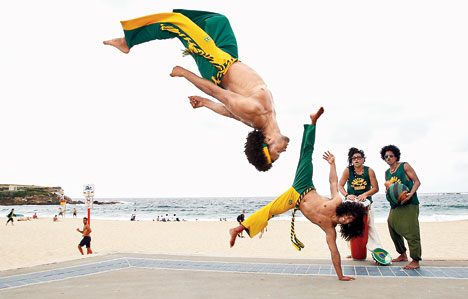
If you’re usually on the lookout for fun ways to get fit, then you might already know a thing or two about Animal Flow. But if you want to get down to its nitty-gritty, then there are few better than London-based master instructor Richard Scrivener. In town for a workshop presented by 212 Degrees, a Calcutta-based platform that organises compact learning courses, he sat down for a chat with t2 on the differences between the two levels of Animal Flow and why it’s a great way to work out. Excerpts from Scrivener speak...
Body map
Animal flow is body weight training, so you need no equipment other than your own body and the ground. What’s great about body weight training is that it really helps you to find out (a) where your strengths are and (b) where your weaknesses are. So if you’re strong in certain positions with your hands on the ground and you can push your body weight then it allows you to perform the movements really well. But if, for example, you have a little bit of a joint limitation or you’re slightly inflexible, you’ll feel it very quickly in those areas because it’s then difficult to perform a movement. So it gives you a map of your body’s function, and very quickly as you work through each Animal Flow movement, in your mind you can create a mental checklist of “I’m good at this one and I’m not so good at this one.” It teaches you a lot about your body, improves your joint awareness, and the more you practise you build the mobility, flexibility and strength that go with it at the same time. You also have fun! It’s an engaging form of training.
Level 2 vis-a-vis Level 1
The complexity, the advancement of the movements from Level 1 to Level 2 is quite significant. Level 2 explores space more, there’s more verticality — up and down — and there’s a lot more rotation close to the ground. The synchronisation between body parts needs to be more finely tuned, and the big defining feature of Level 2 is that we focus a lot on things like energy rolling — so how can you roll energy continuously, how can you redirect energy and change its direction side to side, up and down, forward and back, and sometimes how can you put a break in, so you’ve been moving and all of a sudden you stop and then start again.
Something for everyone
What we’re just doing there is called the kinetic flow — kinetic for energy and transferring energy through each of the movements we’ve learnt. Like yoga, where there’s a lot of arm balancing practice, in Animal Flow we have our own hand balancing/ arm balancing component, where we’re using some influences from things like gymnastics, and that becomes the strength part of Animal Flow and the skill part, which complements all of the mobility, stability and coordination parts as well. So there’s something for everyone. There’s the basic components that are great for posture, mobility, strength and flexibility; there’s the strength component where you’ve got some positions you have to really hold and be very strong in; and there’s also a high skill component if you like challenges like learning how to do tuck balances and standing on your hands.





Permutations and combinations
In Animal Flow, we can learn set flows and perform them in the same way, but the main thing is that you have a number of movements that can be put together in any combination you like. So ultimately there’s an infinite number of flows and combinations as long as your creativity is there. You can find a new way of getting between two movements that you hadn’t tried before — we call that a switch or transition. If I’ve got movement A and movement B, I can transition between them in different ways, and that gives you something unique. So by the time you add up all those variables — do them slow, do them fast — you’ve got a lot of combinations. The goal is you move from A to B and from B to C, and it doesn’t look like they’re separate movements. That’s what you’re trying to achieve in Level 2.
Animals in flow
We have travelling forms, which are the animals that travel. We have ape, beast and crab on Level 1, and then in Level 2 we introduce bear, leopard and crocodile. In Level 2 we teach the students how to actually use the animals in transition. You’ve learnt all of the individual travels, and now we’re giving you the challenge of starting in bear, coz that’s highest off the ground, then dropping the height to leopard, dropping further into the beast, and then dropping it really low to the ground into the crocodile, and if you have more energy you can try and come back again… or stop!
In terms of effort and strength, the crocodile crawl is probably the toughest one. It’s not that far at all before you really start to feel a lot in the shoulders, chest, core and legs. Other movements, perhaps like the beast crawl or an underswitch or some other movement might be more difficult technically — there might be more things to think about — but in terms of muscular effort, the crocodile beats everything else hands down. If we want to make someone sweat and feel a little bit of muscle pain, that’s what we give them!
Practice and progress
If you want to be really good at Animal Flow, and you want to master some of the more challenging movements or the hand balancing, for example, then you’ve got to be putting in multiple sessions in a week. Maybe four or five sessions a week. It doesn’t have to be an hour, it can be 20 minutes or 15 minutes. What I like to recommend to clients, is that if we’re doing a traditional workout, maybe some strength training in the gym, some weight training or some cardio training, I like to use Animal Flow movements in between them.
Typically, a very keen and motivated student can go from Level 1 to Level 2 in one month — 30 days is our minimum time. We say that you should be practising your Level 1 movements when you’ve just learnt them. After 30 days we invite them to submit their video assessment, which they send to us and then we grade them. Some students take a little bit longer — 60-90 days. We don’t give them a strict deadline because circumstances can limit the time that you have to practice. We recommend you try to get it done before 90 days, and that’s normally a good amount of time to work on Level 1.
Similarities with capoeira
Capoeira, the Brazilian dance form/martial art, is very much an expressive art form. It’s got that mix of gymnastics, dance and martial arts, and you’re playing with an opponent, and so the routine is never the same. One of the senior capoeistas at the school I used to go to always said that capoeira is like a conversation, but with movement. So you make a movement towards me, I have to react, and so it’s like a back-and-forth conversation. And it can be quite fast and a little bit aggressive and physical at times, but most of the time capoeira is non-contact. It makes you move in every possible position you can ever imagine. The goal is to manipulate someone to go into a position that they may not want to go in but you want them to go in. In Animal Flow as well, you can do what we call a free flow; you start in a position, and then see where you want to take it — let your body just follow a path that feels right on that day. So there are some similarities, and Animal Flow is influenced by all those different disciplines — capoeira, yoga, martial arts, gymnastics, hand balancing, and even disciplines like parkour and freerunning.










